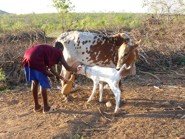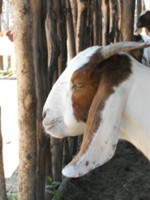
All Photos Credit:ILRI/Flickr
Comprehensive Livestock-Aquaculture Environmental Assessment for Improved Nutrition, a Secured Environment and Sustainable Development along Value Chains.
A new ex-ante environmental framework to secure sustainable livestock and aquaculture production systems
Project Partnership and Team
This is a strategic collaboration led by ILR together with SEI, CIAT , and CSIRO. Key staff involves Mats Lannerstad (ILRI/SEI), Mario Herrero (CSIRO), An Notenbaert (CIAT), Ylva Ran (SEI), Simon Fraval (ILRI), Simon Mugatha (ILRI), Birthe Paul (CIAT), Jennie Barron (SEI), Eric Kemp-Benedict (SEI) , Joanne Morris (SEI)
Executive Summary
 The overall vision of the project is to contribute towards a pro-poor, environmentally responsible livestock sector investment and development with specific reference to developing and emerging countries.Through a pilot study with smallholder dairy farmers in East Africa the project aims to show proof of concept of a new environmental assessment framework. This framework will be designed to ensure that current and proposed actions designed to improve incomes and food security in livestock systems has a minimum environmental footprint while at the same time lifting people out of poverty.
The overall vision of the project is to contribute towards a pro-poor, environmentally responsible livestock sector investment and development with specific reference to developing and emerging countries.Through a pilot study with smallholder dairy farmers in East Africa the project aims to show proof of concept of a new environmental assessment framework. This framework will be designed to ensure that current and proposed actions designed to improve incomes and food security in livestock systems has a minimum environmental footprint while at the same time lifting people out of poverty.
The livestock sector provides livelihoods for 1 billion people, generates 40% of global agricultural GDP, and is a major contributor to food and nutrition security. Driven by continued population growth, rising affluence and urbanization, global consumption of animal products is projected to double by 2050. Almost the entire increase will take place in less developed countries, which will generate as much as three-quarters of global meat production and two thirds of global milk output.
The potential for yield improvement in livestock production systems is large in many countries. This is particularly true for livestock systems with ruminants, as cows, buffalos, goats and sheep. In sub-Saharan Africa (SSA) and South Asia (SA) the meat output relative to biomass feed for cattle is only 50% of the yield in Latin America, and 25% of the yield in industrialized countries. Also, milk production per cow is low in SSA and SA, at about half the level in Latin America.
 The ongoing demand-driven ‘Livestock Revolution’ presents genuine opportunities for livelihood improvement and income generation for resource limited smallholder farming systems in SSA and SA. An intensification of livestock production in these regions will also be required to respond to the growing demand for meat and dairy produce. Intensified animal rearing is demanding of resources. It appropriates cropland and pastures and affects key parameters such as water, nutrients and greenhouse gas (GHG) emissions, thus heightening the risk of undermining the resilience of ecosystems at multiple scales.
The ongoing demand-driven ‘Livestock Revolution’ presents genuine opportunities for livelihood improvement and income generation for resource limited smallholder farming systems in SSA and SA. An intensification of livestock production in these regions will also be required to respond to the growing demand for meat and dairy produce. Intensified animal rearing is demanding of resources. It appropriates cropland and pastures and affects key parameters such as water, nutrients and greenhouse gas (GHG) emissions, thus heightening the risk of undermining the resilience of ecosystems at multiple scales.
To ensure that livestock is a vehicle for sustainable development
The choice of options to increase productivity and income in livestock systems needs to be supported with ex ante analyses of their environmental consequences in order to identify the scale of environmental concerns and to identify trade-offs, co-benefits and, if necessary, mitigation measures. However, there is no consistent way to assess the value of resource use and ecosystem impacts related to livestock production. Consequently, there is an urgent need to develop appropriate evaluation frameworks to ensure that investments in livestock production by private actors, public institutions and donors can be examined from the perspective of environmental sustainability.
Funder: Bill and Melinda Gates Foundation
SEI York Contact: Jennie Barron jennie.barron@sei-international.org
